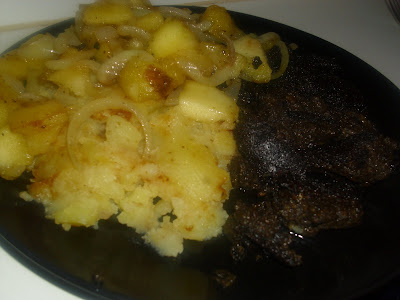 This is the traditional german christmas cake called "Stollen". It's a yeasted cake, that's very high in fat and it's kind of dry because the cake should last very long. It's always full of raisins and candied citrus peel and sometimes it has also a core made of marzipan. After baking the cake gets brushed with a lot of butter (in my case magarine) and coated with a generous layer of confetioners sugar. When this spcial threatment is finished the stollen has to rest at a cool place. Some recipe call for 2-3 weeks of resting time or even more and the recipe I veganized called for 5- 7 days, which I this was enough time. Stollen is a good example for the fact that most of the cakes and cookies, that are served during christmastime in germany are based on recipes from middle ages, because Stollen was first mentioned in 1329. So this is a cake, that people bake for christmas for more than 600 years now. They also they that the cake looks like a baby Jesus wrapped into a white towel because of the shape of the cake and the white coating.
This is the traditional german christmas cake called "Stollen". It's a yeasted cake, that's very high in fat and it's kind of dry because the cake should last very long. It's always full of raisins and candied citrus peel and sometimes it has also a core made of marzipan. After baking the cake gets brushed with a lot of butter (in my case magarine) and coated with a generous layer of confetioners sugar. When this spcial threatment is finished the stollen has to rest at a cool place. Some recipe call for 2-3 weeks of resting time or even more and the recipe I veganized called for 5- 7 days, which I this was enough time. Stollen is a good example for the fact that most of the cakes and cookies, that are served during christmastime in germany are based on recipes from middle ages, because Stollen was first mentioned in 1329. So this is a cake, that people bake for christmas for more than 600 years now. They also they that the cake looks like a baby Jesus wrapped into a white towel because of the shape of the cake and the white coating.I found a recipe on the internet which was easy to veganize because it uses no eggs. This recipe and I am now going to translate it. The only changes I made were to sub magarine for butter and candied orange peel for the succade and I made the preparation a bit easier because the autor calls for some steps that really didn't make sence for me.
Vegan Christstollen
Ingredients:
750 g of wheat flour
375 g of magarine, at room temperature plus some extra magarine for brushing after baking (aprox 3/4 cup)
140 g of white sugar
42 g of bakers yeast or the amount of instant yeast you'll neet to replace that
125 ml of warm soy milk or any other non-dairy milk
375 g of raisins marinated in rum overnight
125 g of chopped almonds ( I bought a package of 100 g and it was ok)
125 g of candied orange peel
1 tsp of nutmeg
1 tbs of cinnamon
1 tsp of salt
200 g of confectioners suagr for coating
1. Place the flour into a large bowl and make a howl in the middle. Crumble the yeast into the howl and add a little bit of the warm soy milk. Mix the yeast and milk with a bit of the flour surrounding it and cover it with a fine layer of flour. Leave at room temperature for about one hour.
2. Add the remaining soy milk, the sugar, the magarine, the salt and the two other spies and mix and knead it until you've got a nice dough, that doesn't stick to the bowl anymore.
3. Add the other stuff except of the magarine and confetioners sugar and mix well.
4. Try to flatten the dough a bit and shape it into a elliptic shape. Folt over the sides. It should now look like this.
5. Wrap the loaf into aluminium foil and put it into the fridge overnight for some extra resting time.
6. At the next day you put the foil away bake it for ten minutes at 220°C and then you lower the heat to 180°C and bake for 45 more minutes. Be carefull not getting it to dark. If the stollen looks very dark during the baking proces should should maybe lower the heat a bit or even cover the loaf with some alumium foil. It's okay when it gets a bit dark but we don't want to burn it.
7. After baking, brush the warm stollen with the melted magarine and cover it completly in confetioners sugar. Wrapp it in aluminium foil and let it mature for 4- 7 days at a cool and dry place. This place isn't your kitchen cupboard even if you son't heat your kitchen. This place might be a cave or something like that. An odorless fridge might be okay as well.
8. When the maturation is done the stollen is ready to be eaten and you can keep it for couple of weeks if you wrap it well after you took a slice. Some people like to spread a thick layer of magarine (traditional butter) on their slice of stollen but well, does anyone need some extra calories at christmas season?































